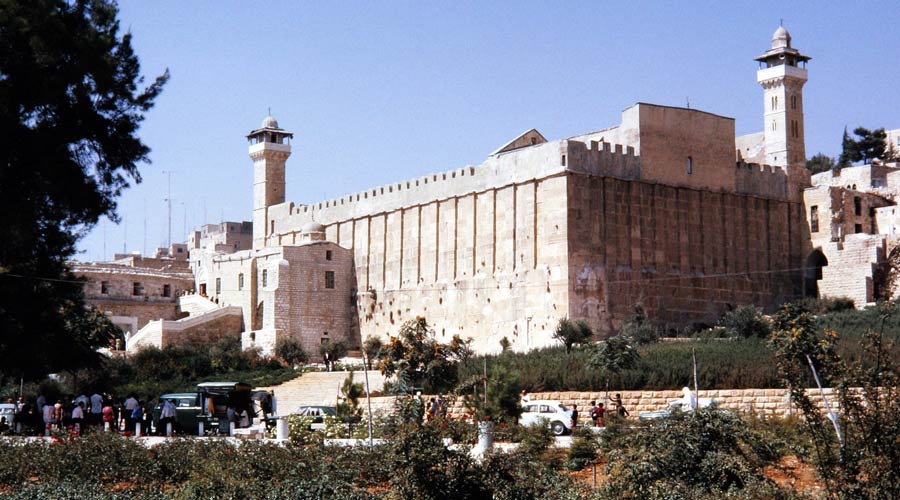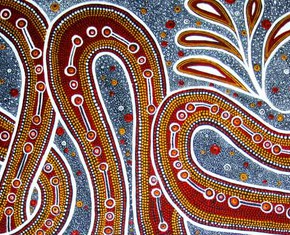The views expressed in our content reflect individual perspectives and do not represent the authoritative views of the Baha'i Faith.
When the prophet Abraham died, Ishmael and Isaac worked together to bury him, though the exact timing of events is unclear.
If Ishmael was already visiting because he had been summoned to the bedside of his ailing father, he and Isaac would have buried Abraham within a day or so of his death. Together—or with the help of servants—the brothers would have cleared out the shaft or tunnel leading to the Cave of Machpelah, which Abraham had so purposefully acquired. Once inside the small cave, they might have gathered the decomposed remnants of Sarah’s body and placed the bones in a box or jar. Or they might have placed Abraham’s corpse near where Sarah lay and left it to future generations to gather the bones of both parents and mingle them in a single container. A few treasured objects might have been placed in the tomb as well.
If Ishmael was summoned after Abraham’s death, and if it took him days, weeks, or months to arrive, the burial of Abraham might have occurred in two stages. Within a day or so of death, his body would have been buried in a shallow pit, probably in a hillside cemetery area the household had been using for years. The gravesite might have been marked with a rough tombstone or a terracotta jug half-buried in the earth. When Ishmael arrived, he and Isaac would have removed Abraham’s desiccated remains, transferred them to a container, and placed the container in the Cave of Macphelah as Abraham intended.
Today, the Cave of Machpelah in Hebron is thought to lie directly underneath a complex of buildings and shrines—some ancient, some newer—known as the Tomb of the Patriarchs.

Tomb of the Patriarchs
Because the shaft leading to the cave was hidden under the floor of the building erected to protect it, the exact location of the shaft was forgotten. It remained unknown for centuries until a monk, Arnulf, reportedly rediscovered it and entered the cave in AD 1119. Christian Crusaders were in control of the area at that time, and a group of them were reportedly so excited by Arnulf’s discovery that they, too, entered the cave, gathered up the bones they found lying there, and carried them into the building above. The bones, it is said, were placed in reliquaries (decorated boxes) and buried beneath the floor of the central building of the Tomb of the Patriarchs rather than being returned to the cave. Then the shaft leading down to the double-chambered cave was resealed. Gruesomely, some of the bones were said to have been given or sold to important pilgrims before the reliquaries were buried.
What today’s visitors see when they enter the Tomb of the Patriarchs are several large, ornately-decorated cenotaphs (boxy structures approximately the size of a pickup truck) that aren’t really tombs at all. They are nothing more than elaborate monuments built two thousand years ago, during the reign of Herod. They are not thought to contain any bones, though no one has taken them apart to find out. If a few original bones do exist at the site, they are likely to be somewhere under the floor of the Tomb of the Patriarchs, still encased in the reliquaries buried by the Crusaders.
The overture to a musical, such as South Pacific or Phantom of the Opera, contains bits and pieces of songs destined to be sung during the full performance.
If you are sitting in a dark auditorium, listening to an overture for the very first time in your life, the music will be both tantalizing and mysterious. It will hint at events to come, yet from the overture alone, you will not be able to guess exactly what will happen. Only after the curtain rises and the actors have assumed their roles will the melodic snippets expand into songs and—one by one—reveal their full glory and meaning.
By stretching the musical analogy a bit, we can apply it to Abraham. Within the bounds of this analogy, Abraham’s life was a tantalizing overture, full of prophetic hints about various songs that would be sung in the millennia ahead. When the overture ended—when Abraham died—it seemed to be the end of everything, but it was merely a necessary pause. Soon the curtain would rise on the full performance, and the prophetic overtones of his life would develop into complete melodies, extolling the beauty of the love of God:
The essence of all religions is the Love of God, and it is the foundation of all the sacred teachings.
It was the Love of God that led Abraham, Isaac, and Jacob, that strengthened Joseph in Egypt and gave to Moses courage and patience.
Through the Love of God, Christ was sent into the world with His inspiring example of a perfect life of self-sacrifice and devotion, bringing to men the message of Eternal Life. It was the Love of God that gave Muhammad power to bring the Arabs from a state of animal degradation to a loftier state of existence.
God’s Love it was that sustained the Bab and brought him to his supreme sacrifice, and made his bosom the willing target for a thousand bullets.
Finally, it was the Love of God that gave to the East Baha’u’llah, and is now sending the light of His teaching far into the West, and from Pole to Pole.
Thus I exhort each of you, realizing its power and beauty, to sacrifice all your thoughts, words and actions to bring the knowledge of the Love of God into every heart. – Abdu’l-Baha, Paris Talks, pp. 82-83.
















Comments
Sign in or create an account
Continue with Googleor